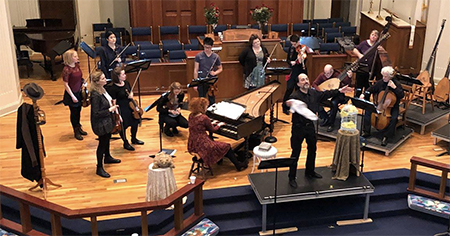by Timothy Robson

Vivaldi’s Concerto for Two Violins, Two Cellos, and Strings in D, RV 564 is a particularly interesting example from the composer’s vast output in its use of solo violins and cellos in contrasting duos and solos, against a small orchestra and continuo. An unusual feature is that the two cellos also support the bass line in the orchestra. Soloists were Johanna Novom and Adriane Post, violins, and René Schiffer and Rebecca Landell Reed, cellos. The tempos were brisk — in the third movement, one of the violinists had to fight to keep up with all of the notes. Sorrell seamlessly elided the transition to the beautifully lyrical second movement.
Sorrell described Bach’s Brandenburg Concerto No. 3 in G as a “tennis match,” and indeed, it was fascinating to hear and watch the interplay among the musicians, who sometimes passed the same musical motif down the line. The ensemble playing was fine, but some of the phrasing and emphasis on first beats of measures in the first movement bordered on being mannered, interrupting the musical flow. Sorrell solved the problem of the “missing” second movement, for which Bach provided nothing but a final cadence, by creating a harpsichord cadenza with a few brief interpolations from solo violin and cello. This set up the return to G major for the third movement, which was presented in an enthusiastically straightforward manner.
Vivaldi’s 1711 Concerto for Four Violins in b (from L’Estro harmonica, Op. 3) was so well-known that Bach transcribed it for four harpsichords and orchestra. The original made a strong effect here, with soloists Susanna Perry Gilmore, Johanna Novom, Adriane Post, and Carrie Krause. It was a brilliant display of soloistic acrobatics, with beautifully contrasted dynamics. The triple meter of the third movement added the difficulties of ornamentation. Near the end, the four soloists play in unison, to striking effect. This was a highlight of the program.
Apollo’s Fire’s programs are often noted for their theatricality, and Telemann’s 15-minute Funeral Cantata for an Artistically Trained Canary-Bird fit right into that ethos. Veteran AF baritone Jeffrey Strauss sang with gusto about his canary (which appeared in a mass of disheveled yellow feathers) that had been killed by the local cat (who appeared in lifeless and chubby stuffed form). Strauss sang Sorrell’s English translation with such clarity that it wasn’t necessary to refer to the printed text in the program. There were scenery-chewing antics galore, but also some tender musical moments in which the canary’s owner laments the loss of his feathered friend.
Continuing the avian theme, Kathie Stewart was a fine traverso soloist in Vivaldi’s Flute Concerto in D, “Il Gardellino” (The Goldfinch), playing birdsong-like trills and arpeggios. Balances were nicely proportioned, the strings never covering the soloist, and the second movement, “Cantabile,” was a particularly beautiful pastorale, its repeat soft, with plucked string continuo and tasteful ornamentation. In the third movement, the flute is more a part of the orchestral texture, often in duet with the first violin. The accelerando to the final cadence added further excitement to this excellent performance.
The dance tune La Folia inspired several works, including Vivaldi’s Trio Sonata in d, RV 63. Sorrell previously arranged it as a concerto grosso for Apollo’s Fire, and it has become a signature piece for the ensemble. This was the first performance of a new version of that arrangement, in which the two solo violinists (Alan Choo and Emi Tanabe) challenge each other to greater flights of embellishment and virtuosity. The whole orchestra played from memory, the effect of which was even more cohesive than usual. It was a rousing conclusion to a fascinating concert.
Published on ClevelandClassical.com March 11, 2019.
Click here for a printable copy of this article



